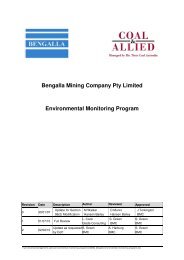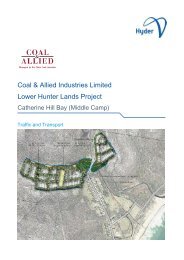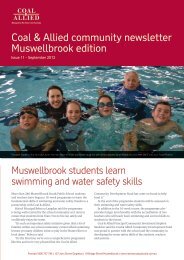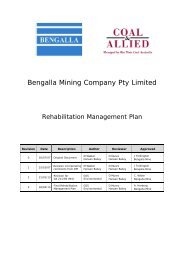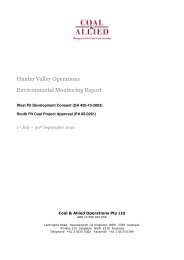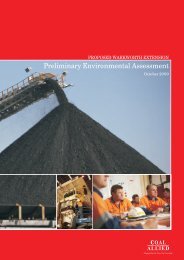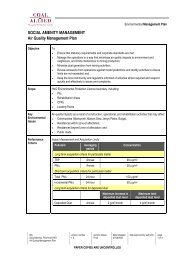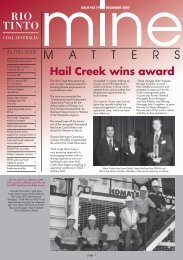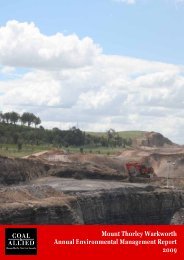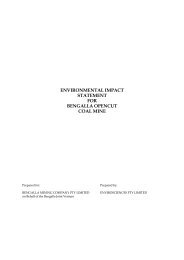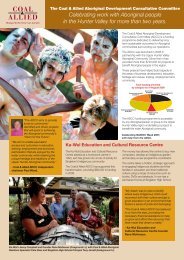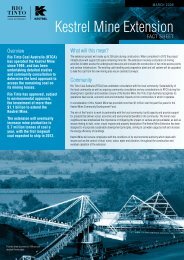HVO 2009 Annual Environmental Management Report - Final
HVO 2009 Annual Environmental Management Report - Final
HVO 2009 Annual Environmental Management Report - Final
Create successful ePaper yourself
Turn your PDF publications into a flip-book with our unique Google optimized e-Paper software.
Coal & Allied – Hunter Valley Operations<br />
3.2.2 <strong>Environmental</strong> Performance<br />
Depositional Dust<br />
To monitor regional air quality, <strong>HVO</strong> operated and maintained a network of 10 depositional dust gauges on<br />
private land. Depositional dust was monitored monthly in accordance with AS 3580.10.1 (2003) – (Methods<br />
for Sampling and Analysis of Ambient Air – Determination of Particulates – Deposited Matter – Gravimetric<br />
Method). Sites were analysed for mass, total insoluble matter and ash.<br />
<strong>Annual</strong> Average Assessment<br />
Table 17 and Figure 20 show the average depositional dust results for <strong>2009</strong> compared with the depositional<br />
dust impact assessment criterion of 4g/m 2 /month (annual average for total insoluble solids). During <strong>2009</strong> all<br />
sites complied with the criteria.<br />
Depositional dust gauges located on Coal & Allied owned mining land provide additional information for the<br />
dust management at <strong>HVO</strong>. A dust isopleth (Figure 22) shows the average depositional dust results for <strong>2009</strong> at<br />
all gauges.<br />
An additional impact assessment criterion of a maximum increase of 2g/m 2 /month annual average for total<br />
insoluble solids applies to <strong>HVO</strong> depositional dust. The normal intention of this criterion is to limit the increase<br />
in dust deposition from the pre-mining situation to the levels that apply when mining has commenced. As<br />
there are no instruments available to distinguish the dust contributed by the mine compared with the dust from<br />
other sources, environmental performance against this condition cannot comprehensively be tested via the<br />
monitoring programme. Results indicated that this condition was complied with in <strong>2009</strong> (Figure 21). However,<br />
most sites reported an increase in dust levels from the previous results, with the exception of D118, DL14 and<br />
Warkworth School. This conceivably is the result of lower than average rainfall for <strong>2009</strong> compared with 2008.<br />
Data recovery for the 10 dust deposition gauges was 98 per cent. Two samples were unable to recover data<br />
due to broken dust deposition bottles.<br />
A number of the samples were contaminated by material or various activities that may have altered the results<br />
from a true reading of dust deposition. Contamination was assessed based on field observations, laboratory<br />
analysis, mine activities, historical data and wind patterns. Samples can include organic material such as bird<br />
droppings, insects and vegetation. Insoluble solids may have been from a localised non-mine source such as<br />
livestock or farm activities. Therefore, results may not be representative of mining’s contribution to dust<br />
deposition. High monthly results (ie >4g/m 2 /month) are summarised in<br />
Table 18. Depositional dust data is provided in Appendix 6.<br />
AEMR <strong>2009</strong> 57



